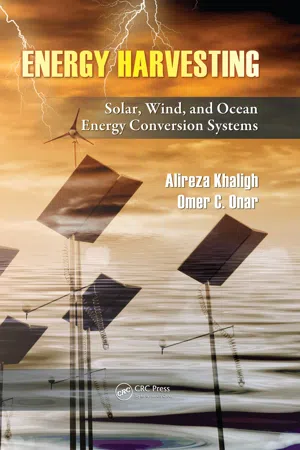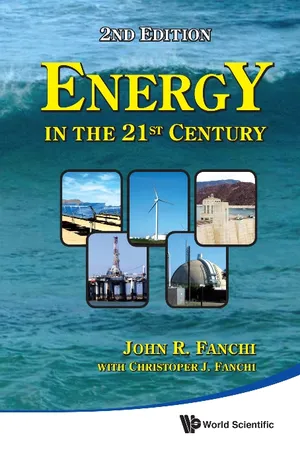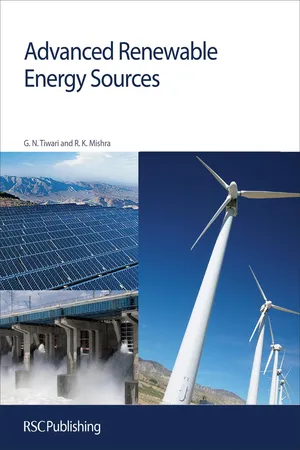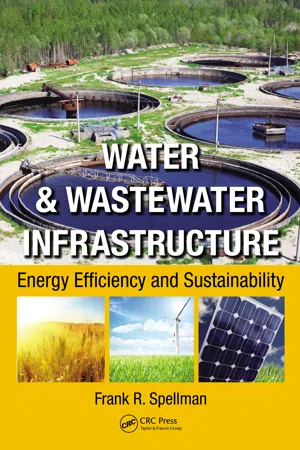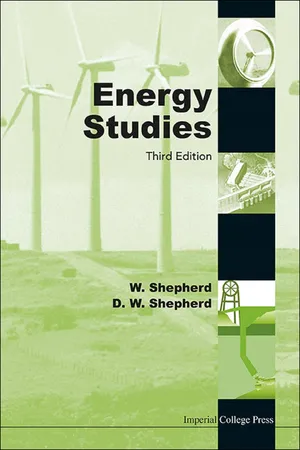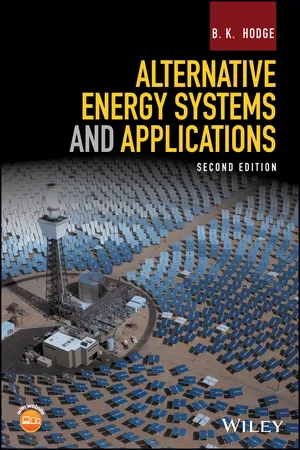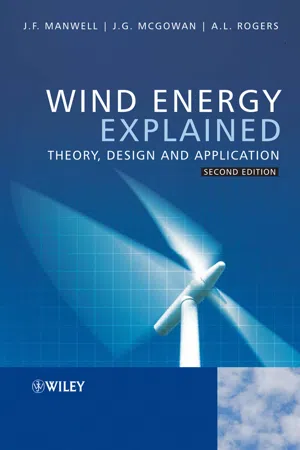Physics
Wind Energy
Wind energy is a renewable energy source that harnesses the power of the wind to generate electricity. It is produced by wind turbines, which convert the kinetic energy of the wind into mechanical power. This power is then used to drive generators that produce electricity. Wind energy is a clean and sustainable alternative to traditional fossil fuels.
Written by Perlego with AI-assistance
Related key terms
1 of 5
10 Key excerpts on "Wind Energy"
- eBook - ePub
Energy Harvesting
Solar, Wind, and Ocean Energy Conversion Systems
- Alireza Khaligh, Omer C. Onar(Authors)
- 2017(Publication Date)
- CRC Press(Publisher)
2 Wind Energy Harvesting2.1 Introduction
Wind is the airflow that consists of many gases in the atmosphere of the earth. Rotation of the earth, uneven heating of the atmosphere, and the irregularities of the ground surface are the main factors that create winds. Motion energy of the wind flow is used by humans for many purposes such as water pumping, grain milling, and generating electricity. Windmills that are used for electricity generation are called wind turbines in order to distinguish them from the traditional mechanical wind power applications.Wind is a sustainable energy source since it is renewable, widely distributed, and plentiful. In addition, it contributes to reducing the greenhouse gas emissions since it can be used as an alternative to fossil-fuel-based power generation [1 ]. Wind turbines capture the kinetic energy of winds and convert it into a usable form of energy. The kinetic energy of winds rotates the blades of a wind turbine. The blades are connected to a shaft. The shaft is coupled to an electric generator. The generator converts the mechanical power into electrical power.Even though wind turbines currently provide only 1% of the worldwide power supply, Wind Energy is one of the fastest growing renewable energy technologies all over the world. In countries such as Denmark, Spain, Portugal, and Germany, wind power accounts for approximately 19%, 9%, 9%, and 6% of the required electric power, respectively. From 2000 to 2007, the global wind power generation increased to approximately five times of its previously recorded capacity [2 ].Wind Energy conversion systems (WECS) involve many fields of various disciplines such as kinematics, mechanics, aerodynamics, meteorology, power electronics, power systems, as well as topics covered by structural and civil engineering. The main focus of this book is on electrical power interfaces and grid-connected topologies for WECS.This chapter firstly focuses on some basic features of winds. A brief history of Wind Energy is presented in Section 2.3 . Fundamentals of Wind Energy harvesting, basic parts of wind turbines, and the wind turbine types are described in Sections 2.4 and 2.5 - eBook - PDF
- John R Fanchi(Author)
- 2010(Publication Date)
- World Scientific(Publisher)
148 CHAPTER 7 RENEWABLE ENERGY – Wind Energy The kinetic energy of wind and flowing water are indirect forms of so-lar energy and are considered renewable. Wind Energy technology relies on gradients in physical properties such as atmospheric pressure to gen-erate electrical power. Wind turbines harness Wind Energy and convert the mechanical energy of a rotating blade into electrical energy in a gene-rator. The objective of this chapter is to discuss the use of wind as a source of energy for generating useful power. We begin by reviewing the history of wind power. 7.1 H ISTORY OF W IND P OWER Wind has been used as an energy source for thousands of years. Histori-cal applications include sails for ship propulsion and windmills for grinding grain and pumping water. Wind is still used today as a source of power for sailing vessels and parasailing. The earliest known applications of wind as an energy source come from Persia [Manwell, et al., 2002]. Around 900 A.D., wind was used to drive early vertical axis windmills. Modern wind turbines are classified as either horizontal axis turbines or vertical axis turbines. A vertical axis tur-bine has blades that rotate around a vertical axis and its visual appearance has been likened to an eggbeater. A horizontal axis turbine has blades that rotate around a horizontal axis (see Figure 7-1). Horizon-tal axis turbines are the most common turbines in use today. Early vertical axis windmills had a simple design and were particularly susceptible to damage in high winds. The f technolog Ages. Ho such as p windmills Figure 7 -Wind turies prio energy so not alway energy m and wher as a com tent, wate be moved use in co R Figu first known gy seen pre orizontal axi pumping wa s typically h -2. power was or to the Ind ource lost f ys available mix because re it was mo mbustible fue er also over d through w ontainers su R enewable ure 7 -1. - eBook - ePub
- Gopal Nath Tiwari, Rajeev Kumar Mishra(Authors)
- 2015(Publication Date)
- Royal Society of Chemistry(Publisher)
CHAPTER 7 Wind Energy7.1 INTRODUCTION
In the past, Wind Energy was used (i) to propel ships (ii) to produce mechanical energy for pulling up underground water from wells and (iii) grinding agriculture products. There is also evidence that suggests that the ancient Egyptians used windmills to pump water for irrigating agricultural lands and to grind grains during 3600 B.C. Wind is simply air in motion that carries kinetic energy with it. The kinetic energy is converted into first mechanical and then electrical energy by generation. The mechanical energy of wind can be used for driving ships, pumping water, grinding grains, etc.The harnessing of electrical power from wind is gaining momentum due to the depletion of fossil fuels and their rising running cost. Moreover, Wind Energy is considered to be a green/clean power technology. It has minor impacts on the economy and environment. Hence, Wind Energy, which is a renewable sources of energy, can be harnessed to provide an environmentally friendly and reliable source of energy without producing any air pollutants or greenhouse gases. The kinetic energy of wind is captured by the wind turbine that is mechanically coupled to an electrical generator. The turbine is mounted on a tall pillar to enhance the energy capture. In the 19th century, wind turbines contributed greatly to the economic development of many countries like the Netherlands, Denmark and the USA. The use of Wind Energy declined very fast everywhere due to the cheap availability and exploitation of coal, oil and gas resources.The old wind turbines were no longer economically competitive with conventional sources of energy. Therefore, very little research was done to develop new and more efficient wind turbines. Due to the energy crisis during 1973 the development of new and more efficient wind turbines was resumed to generate electricity. As a result, the cost of electricity produced by wind turbines decreased dramatically due to improved technology. Nowadays, the extraction of electrical power with modern turbines from the wind is an established industry. A device for direct mechanical work is often called a windmill or just wind turbines. If electricity is produced, the combination of turbine and generator may be called a wind generator or aerogenerator that is also referred as a Wind Energy-conversion system (WECS) - eBook - ePub
- Frank R. Spellman(Author)
- 2016(Publication Date)
- CRC Press(Publisher)
wind power.Wind generator—A Wind Energy conversion system designed to produce electricity.Wind load—The lateral pressure on a structure, in pounds per square foot, due to wind blowing in any direction.Wind power—Power generated by converting the mechanical energy of the wind into electrical energy through the use of a wind generator. See also Wind Energy.Wind power plant—A group of wind turbines interconnected to a common utility system.Wind project—Can vary in size, from small projects of one to a few turbines (known as “behind the meter” or “distributed wind systems”) serving individual customers to large projects (“utility” or “commercial-scale”) designed to provide wholesale electricity to utilities or an electricity market.Wind turbine—A Wind Energy conversion device that produces electricity; it typically consists of three major mechanical components: tower, nacelle, and rotor.Wind turbine lay-down area—An area adjacent to the wind turbine foundation where wind turbine components are temporarily stored, assembled, or processed as part of the wind turbine assembly operation.AIR IN MOTION
In all dynamic situations, forces are necessary to produce motion and changes in motion. The atmosphere, which is made up of various gases, is subject to two primary forces: gravity and pressure differences from temperature variations. Gravity (gravitational forces) holds the atmosphere close to the Earth’s surface. Newton’s law of universal gravitation states that every body in the universe attracts another body with a force equal toF = G()m 1m 2r 2where F is the magnitude of the gravitational force between the two bodies, G is the gravitational constant ≈ 6.67 × 10−11 N (m2 /kg2 ), m1 and m2 are the masses of the two bodies, and r is the distance between the two bodies.The force of gravity decreases as an inverse square of the distance between the two bodies. Thermal conditions affect density, which in turn affects vertical air motion and planetary air circulation (and how air pollution is naturally removed from the atmosphere). Although forces acting in other directions can overrule gravitational force, gravity constantly acts vertically downward, on every gas molecule, which accounts for the greater density of air near the Earth. - eBook - PDF
Water & Wastewater Infrastructure
Energy Efficiency and Sustainability
- Frank R. Spellman(Author)
- 2013(Publication Date)
- CRC Press(Publisher)
Yaw motor —The yaw motor powers the yaw drive. 16.8 Wind Energy and Power Calculations A wind turbine is a machine that converts the kinetic energy in wind into the mechani-cal energy of a shaft. Calculating the energy and power available in the wind relies on knowledge of basic physics and geometry. The kinetic energy of an object is the extra energy it possesses because of its motion. It is defined as the work necessary to accelerate a body of a given mass from rest to its current velocity. Once in motion, a body maintains it kinetic energy unless its speed changes. The kinetic energy of a body is given by the following equation: Kinetic energy = 0.5 × m × v 2 (16.2) where m = Mass v = Velocity n Example 16.1. Determining Power in the Wind Let’s say we have a large packet of wind of thickness D that passes through the plane of a wind turbine’s blades, which sweep out at cross-sectional area A (see Figure 16.6). Step 1: To determine power in the wind, we must first consider the kinetic energy of the packet of air shown in Figure 16.6, along with its mass ( m ) and velocity ( v ), as shown in Equation 16.2. Next, we need to divide by time to get power: Power through area passing through A m A t = 1 2 v 2 (16.3) Step 2 : The mass flow rate can be expressed as follows (where ρ is air density, the mass per unit volume of Earth’s atmosphere): DID YOU KNOW? During rotation of the nacelle, it is possible for the cables inside the tower to twist, with the cables becoming more and more twisted if the turbine keeps turning in the same direction. The wind turbine is therefore equipped with a cable twist counter, which notifies the controller that it is time to straighten the cables (Khaligh and Onar, 2010). - eBook - ePub
- Ibrahim Dinçer, Dogan Erdemir, Ibrahim Dincer(Authors)
- 2023(Publication Date)
- Wiley(Publisher)
Major landforms can accelerate wind, resulting in some regions being very windy while others remain relatively calm. By converting wind power into electricity, wind power can be transported over long distances, serving the needs of urban centers with large populations. One of the fastest-growing renewable energy sources in the world is Wind Energy. Technology developments, environmental concerns, and the continuous increase in conventional energy use have led to a reduction in relative Wind Energy costs in many locations to economically acceptable levels as a result of concerns over fossil fuel demand. As a result, many jurisdictions are considering Wind Energy farms as an alternative energy source because they have been installed and operating for more than 25 years. Electricity is produced by wind turbines by converting the kinetic energy of the wind to shaft power. The shaft power is transmitted to the generator by transmission. Figure 7.7 demonstrates the wind power generation mechanism. Modern large-scale wind turbines convert wind kinetic energy into rotational motion by mounting a rotor on which the device to catch the wind is mounted. Wind turbines usually have a three-bladed assembly at the front, but other geometries and types are also available. Wind turbines have a rotor that spins a shaft, which transfers motion to the nacelle. A gearbox inside the nacelle increases the rotational speed of the slowly rotating shaft. Several hundred volts of electricity are generated by converting the rotational motion of the output shaft into electricity at a medium voltage. A transformer (a few thousand volts) increases the voltage of the electric power to a level more appropriate for distribution (a few thousand volts) by passing it through heavy electric cables inside the tower. By using higher voltage electricity, fewer power losses and less heat will be generated through electric lines as a result of fewer resistances - eBook - PDF
- Ahmed F Zobaa, Ramesh C Bansal(Authors)
- 2011(Publication Date)
- World Scientific(Publisher)
Section 1 Wind Energy and Their Applications This page intentionally left blank This page intentionally left blank Chapter 1 Wind Energy Resources: Theory, Design and Applications Fang Yao School of Electrical, Electronic and Computer Engineering, Faculty of Engineering, Computer and Mathematics, University of Western Australia [email protected] Ramesh C. Bansal School of Information Technology and Electrical Engineering, The University of Queensland, Australia [email protected] Zhao Yang Dong Department of Electrical Engineering, The Hong Kong Polytechnic University, Hong Kong Ram K. Saket Department of Electrical Engineering, Institute of Technology, Banaras Hindu University, Varanasi (U.P.), India Jitendra S. Shakya Samrat Ashok Technological Institute, Vidisha, M.P., India The technology of obtaining Wind Energy has become more and more important over the last few decades. The purpose of this chapter is to provide a general dis-cussion about wind power technology. The fundamental knowledge of wind power systems and their design aspects are presented. The description of the fundamental topics which are essential to understand the Wind Energy conversion and its eventual use is also provided in the chapter. This chapter discusses the wind farms and hybrid power systems as well. 3 4 F. Yao et al. 1.1 Introduction Wind power is one of the renewable energy sources which has been widely developed in recent years. Wind Energy has many advantages such as no pollution, relatively low capital cost involved and the short gestation period. The first wind turbine for electricity generation was developed at the end of the 19th century. From 1940 to 1950, two important technologies, i.e., three blades structure of wind turbine and the AC generator which replaced DC generator were developed. 1 During the period of 1973 to 1979, the oil crises led to lots of research about the wind generation. - eBook - ePub
- W Shepherd, D W Shepherd(Authors)
- 2014(Publication Date)
- ICP(Publisher)
CHAPTER 10
Wind Energy
10.1.Nature and Origin of the Wind
10.1.1.Atmospheric pressure[1 ]The wind is the motion of a mass of air. For the purpose of using Wind Energy it is normally the horizontal component of the wind that is of interest. There is also a vertical component of the wind that is very small compared with the horizontal component, except in local disturbances such as thunderstorm updrafts.At the earth’s surface the atmospheric pressure is measured in the unit called the pascal (Pa) and has an average value 101.325 kilopascal (kPa), which is sometimes called “one atmosphere”. Another unit of pressure used for meteorological calculations is the millibar (mbar). There are exactly 100Pa per millibar so that one atmosphere is about 1000mbars. On a map regions of equal atmospheric pressure are identified by isobar lines such as those illustrated in Fig. 10.1 . A close concentration of isobar lines indicates a high pressure gradient or region of rapid pressure change. Wind speed is directly proportional to the pressure gradient.The atmospheric pressure varies from place to place and from day to day, caused by the combined effects of solar heating and the rotation of the earth. As the earth spins, anticlockwise, the atmospheric air surrounding it is dragged round with it at different levels depending on altitude. The mix of air forms turbulence, causing wind at the earth surface.An additional feature is the inertial force known as the Coriolis force, which occurs in rotational systems. When air moves over the surface of the earth as it rotates, instead of travelling in a straight line the path of the moving air veers to the right. The effect is that air moving from an area of higher pressure to an area of lower pressure moves almost parallel to the isobars. In the northern hemisphere the wind circles in a clockwise direction towards the area of low pressure but in the southern hemisphere the wind circles in an anticlockwise direction.Fig. 10.1.Atmospheric pressure isobars for North America, April 2008 [1 - eBook - ePub
- B. K. Hodge(Author)
- 2017(Publication Date)
- Wiley(Publisher)
4 Wind Energy4.1 Introduction
Wind Energy, like solar energy, has captured much media attention recently. Indeed, Wind Energy has exhibited the most rapid growth of all renewable energy sources in the last few years. As shown in Figure 1.11 , Wind Energy accounted for 18% of the renewable energy used in the USA in 2014, up from 4% in 2007. Figure 1.12 illustrates the rapidity of the increase in installed Wind Energy capacity in the USA from 2000 to 2013. Wind Energy is also an increasingly important component of the energy mix in western Europe. The purposes of this chapter are to develop the fundamental principles of Wind Energy and to impart a quantitative understanding of Wind Energy.Devices to harvest Wind Energy are available in many different configurations. A number of possible configurations are illustrated in Figures 4.1 and 4.2 . Fundamental designations of a Wind Energy device include the HAWT shown in Figure 4.1 and the VAWT in Figure 4.2 . The designation depends simply on the axis of rotation of a wind machine: HAWT devices rotate in the horizontal plane and VAWT devices rotate in the vertical plane. HAWT devices are more common than VAWTs, but horizontal devices must have a mechanism – a yaw control – to keep them pointed into the wind. VAWTs, on the other hand, do not need a yaw control.Horizontal-axis wind turbine (HAWT) taxonomy. Source: Kreith and West (1997). Reproduced with permission of Taylor and Francis.Figure 4.1Vertical-axis wind turbine (VAWT) taxonomy. Source: Kreith and West (1997). Reproduced with permission of Taylor and Francis.Figure 4.2Many of the Wind Energy devices illustrated in Figures 4.1 and 4.2 are speculative; they have little or no demonstrated functionality and are not available commercially. The most common configurations for the HAWT are the two- and three-bladed, the windmill, and the sail wing. The two- and three-bladed wind turbines can be either upwind or downwind, with upwind being the most common. In terms of installed kilowatts, the total capacity of the HAWTs greatly exceeds that of the VAWTs. Figure 4.3 presents photographs of HAWTs and VAWTs; Figure 4.3a shows a large HAWT, suitable for commercial power generation, and the turbine in Figure 4.3b - eBook - PDF
Wind Energy Explained
Theory, Design and Application
- James F. Manwell, Jon G. McGowan, Anthony L. Rogers(Authors)
- 2010(Publication Date)
- Wiley(Publisher)
The section after that reviews wind resource measurement techniques and instrumentation. The chapter concludes with a summary of a number of advanced topics in the area of wind resource characterization. Wind Energy Explained: Theory, Design and Application, Second Edition James Manwell, Jon McGowan, and Anthony Rogers Ó 2009 John Wiley & Sons, Ltd There are a number of other sources of information on wind characteristics as related to Wind Energy. These include the classic references Putnam (1948) as well as books by Eldridge (1980), Johnson (1985), Freris (1990), Spera (1994) and Burton et al. (2001). In addition, this text will refer to wind resource material included in several books devoted to this subject. These include the work of Justus (1978), Hiester and Pennell (1981), and the text of Rohatgi and Nelson (1994). 2.2 General Characteristics of the Wind Resource In discussing the general characteristics of the wind resource it is important to consider such topics as the global origins of the wind resource, the general characteristics of the wind, and estimates of the wind resource potential. 2.2.1 Wind Resource: Global Origins 2.2.1.1 Overall Global Patterns The original source of the renewable energy contained in the earth’s wind resource is the sun. Global winds are caused by pressure differences across the earth’s surface due to the uneven heating of the earth by solar radiation. For example, the amount of solar radiation absorbed at the earth’s surface is greater at the equator than at the poles. Thevariation in incoming energy sets up convective cells in the lower layers of the atmosphere (the troposphere). In a simple flow model, air rises at the equator and sinks at the poles. The circulation of the atmosphere that results from uneven heating is greatly influenced by the effects of the rotation of the earth (at a speed of about 1670 kilometers per hour at the equator, decreasing to zero at the poles).
Index pages curate the most relevant extracts from our library of academic textbooks. They’ve been created using an in-house natural language model (NLM), each adding context and meaning to key research topics.
